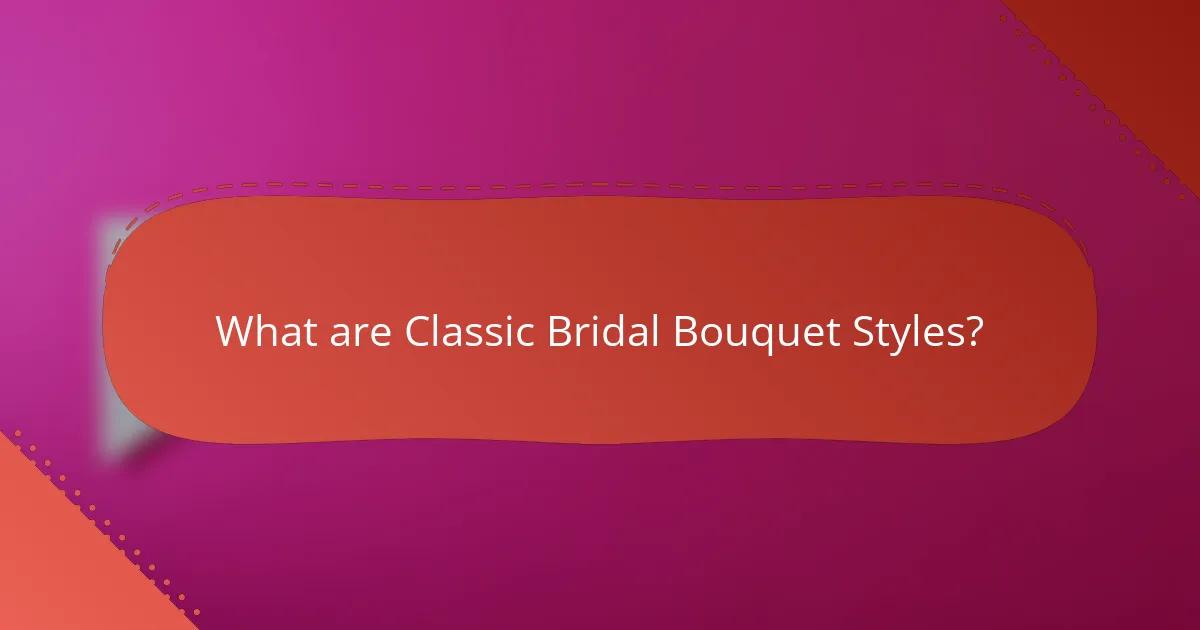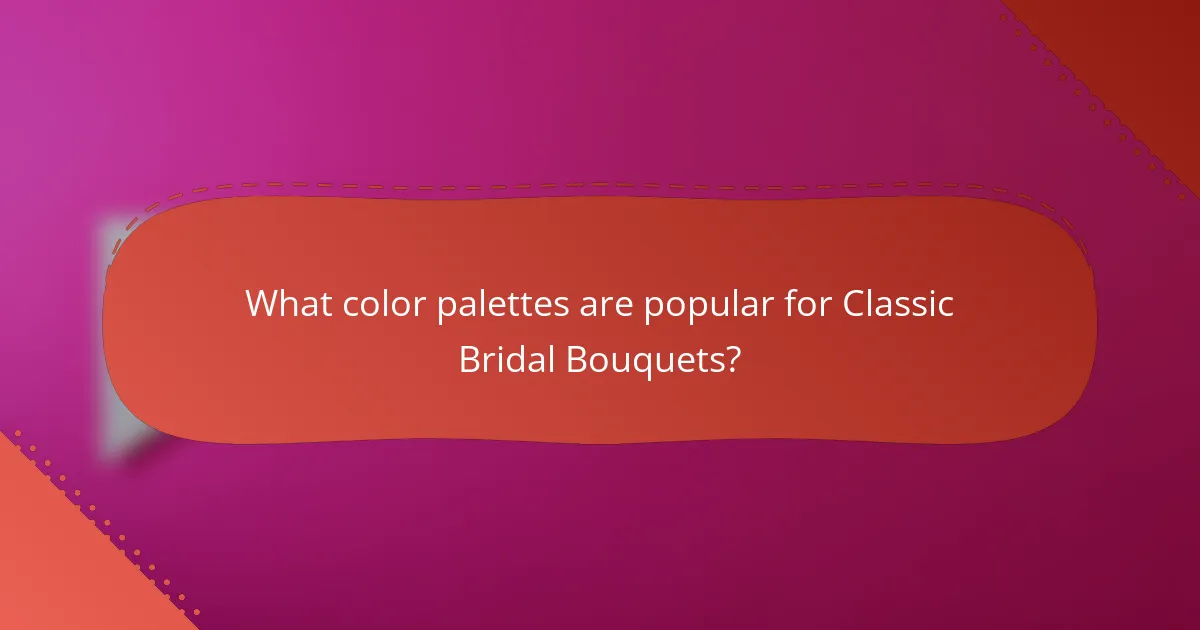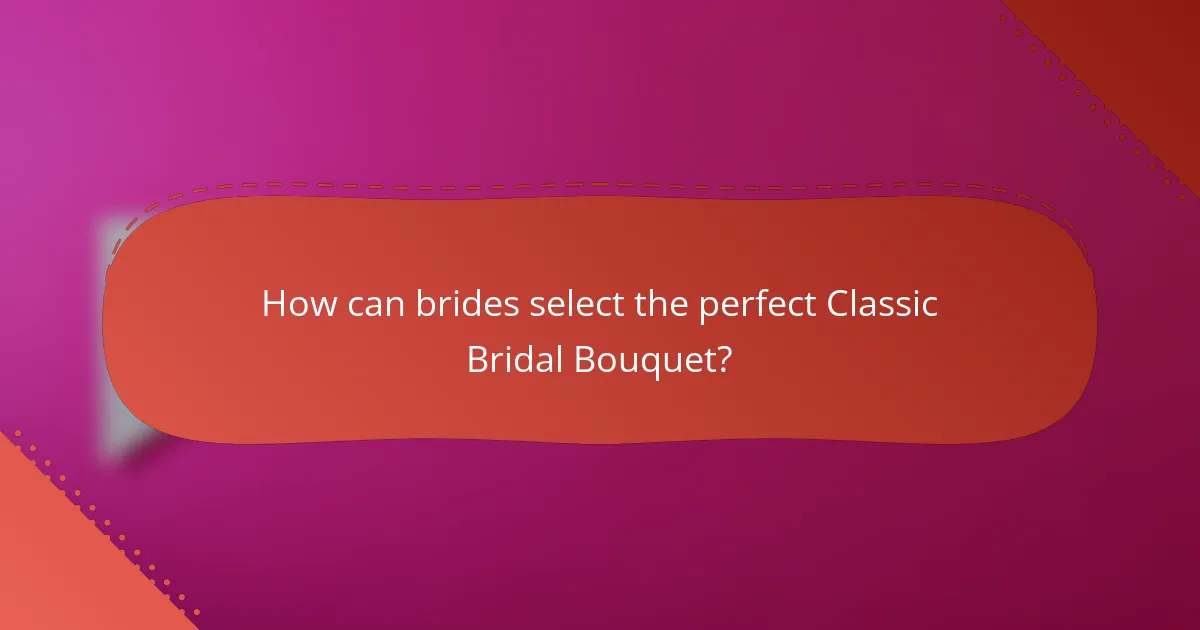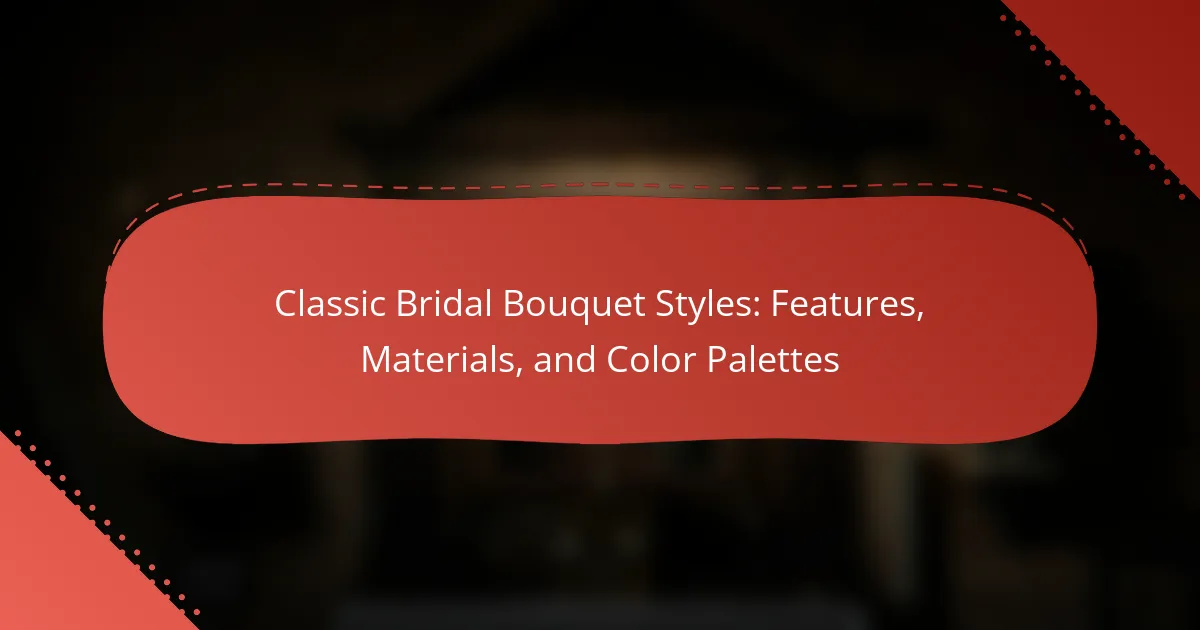
What are Classic Bridal Bouquet Styles?
Classic bridal bouquet styles include round, cascade, and posy arrangements. Round bouquets are compact and feature a dome shape. They are often made with roses or peonies. Cascade bouquets have a flowing design, resembling a waterfall. This style typically includes long-stemmed flowers like orchids or lilies. Posy bouquets are small and hand-held, often featuring a mix of flowers and greenery. Each style has its unique aesthetic and is chosen based on the bride’s preference and wedding theme.
How do Classic Bridal Bouquet Styles differ from modern styles?
Classic bridal bouquet styles typically feature round, compact shapes with a more traditional floral arrangement. These bouquets often emphasize symmetry and use classic flowers like roses and lilies. In contrast, modern styles embrace asymmetry and a more freeform design. Modern bouquets may incorporate unconventional flowers and materials, including succulents and greenery. The color palettes also differ; classic bouquets often stick to soft, pastel tones, while modern styles can include bold, vibrant colors. This shift reflects evolving wedding trends and personal expressions of style.
What historical influences shaped Classic Bridal Bouquet Styles?
Classic bridal bouquet styles were shaped by various historical influences. The Victorian era emphasized elaborate floral arrangements, reflecting the romantic ideals of the time. During this period, flowers symbolized specific meanings, guiding choices for bridal bouquets. The use of white flowers became popular in the 19th century, symbolizing purity and innocence, particularly after Queen Victoria’s wedding in 1840. Additionally, the Art Nouveau movement introduced organic shapes and flowing lines in bouquet designs. The post-World War II era saw a shift towards simpler, more modern styles, influenced by changing social norms. Each of these historical contexts contributed to the evolution of classic bridal bouquet styles, creating a rich tapestry of floral traditions.
What are the defining characteristics of Classic Bridal Bouquet Styles?
Classic bridal bouquet styles are characterized by their timeless elegance and traditional floral arrangements. These bouquets often feature round or cascading shapes, creating a balanced and harmonious look. Common flowers used include roses, peonies, and lilies, which symbolize love and purity. Classic bouquets typically utilize a limited color palette, favoring whites, creams, and pastels. They may incorporate greenery for texture and depth, enhancing the overall aesthetic. Additionally, classic bridal bouquets often employ structured designs, showcasing meticulous craftsmanship. This style remains popular due to its association with romance and tradition in wedding ceremonies.
What are the common features of Classic Bridal Bouquets?
Classic bridal bouquets typically feature a round or cascading shape. They often include a mix of traditional flowers like roses, peonies, and lilies. Greenery, such as eucalyptus or ferns, is commonly used for texture. Classic bouquets usually have a soft color palette, often incorporating whites, creams, and pastels. They are often wrapped in satin or lace for an elegant finish. Many classic bouquets are designed to complement the bride’s gown. The use of seasonal flowers is also a common practice. These features create a timeless and romantic aesthetic for weddings.
What types of shapes are typical for Classic Bridal Bouquets?
Classic bridal bouquets typically feature round, cascade, and hand-tied shapes. The round shape is characterized by a compact, symmetrical design. This style is popular for its classic and romantic appeal. The cascade shape has a waterfall effect, with flowers trailing downwards. It adds drama and elegance to the overall look. Hand-tied bouquets consist of loosely arranged flowers, often with natural stems visible. This style offers a more casual and organic appearance. Each shape serves different aesthetic preferences and complements various wedding themes.
How do size and scale impact the choice of a Classic Bridal Bouquet?
Size and scale significantly impact the choice of a Classic Bridal Bouquet. A larger bouquet can create a dramatic effect and complement a voluminous wedding dress. Conversely, a smaller bouquet may better suit a simpler gown, maintaining balance in the overall look. The scale of the bouquet should also consider the bride’s height and body type. Taller brides may opt for elongated bouquets, while shorter brides might choose rounder styles. Additionally, the wedding venue’s size plays a role; grand settings may require larger arrangements to stand out. Ultimately, the bouquet’s size should harmonize with the wedding theme and personal style.
What materials are used in Classic Bridal Bouquets?
Classic bridal bouquets typically use fresh flowers, greenery, ribbons, and other embellishments. Common flowers include roses, peonies, and lilies. Greenery like eucalyptus or ferns adds texture. Ribbons often complement the bouquet’s color scheme. Some bouquets may incorporate lace or beads for decoration. Floral foam or wire might be used for structure. These materials create an elegant and traditional aesthetic.
What types of flowers are commonly found in Classic Bridal Bouquets?
Classic bridal bouquets commonly feature roses, peonies, lilies, and hydrangeas. Roses are favored for their elegance and variety. Peonies provide a lush, romantic look. Lilies add a touch of sophistication and fragrance. Hydrangeas contribute volume and texture to the arrangement. These flowers are traditionally chosen for their beauty and symbolism in weddings. The combination of these blooms creates a timeless and classic bridal bouquet.
How do foliage and greenery enhance Classic Bridal Bouquets?
Foliage and greenery enhance Classic Bridal Bouquets by adding texture and depth. They create a lush appearance that complements the flowers. The incorporation of different shades of green provides contrast and visual interest. Greenery can also fill empty spaces, making bouquets appear fuller. Additionally, foliage can introduce unique shapes and silhouettes. Popular choices include eucalyptus, ferns, and ivy. These elements can evoke a romantic or rustic feel, depending on the style. Overall, foliage enriches the overall aesthetic of a classic bridal bouquet.

What color palettes are popular for Classic Bridal Bouquets?
Popular color palettes for classic bridal bouquets include soft pastels, rich jewel tones, and elegant neutrals. Soft pastels often feature shades like blush pink, lavender, and mint green. Rich jewel tones incorporate deep colors such as burgundy, emerald green, and navy blue. Elegant neutrals typically consist of white, cream, and soft taupe. These palettes align with traditional wedding aesthetics. They create a timeless and romantic visual appeal. Many brides choose these colors based on their wedding themes and personal preferences.
How do color choices influence the overall wedding theme?
Color choices significantly influence the overall wedding theme. They set the mood and tone for the event. Specific colors evoke different emotions; for example, red symbolizes love, while blue conveys calmness. The selected color palette impacts floral arrangements, attire, and decorations. Consistent color schemes create a cohesive look throughout the wedding. Studies show that color psychology affects guests’ perceptions and experiences. For instance, warm colors can energize a space, while cool colors promote relaxation. Ultimately, color choices are essential in defining the wedding’s aesthetic and atmosphere.
What are the most popular color combinations for Classic Bridal Bouquets?
The most popular color combinations for classic bridal bouquets include white and green, blush and ivory, and red and white. White and green combinations create a timeless and elegant look. Blush and ivory provide a soft and romantic aesthetic. Red and white combinations convey passion and classic beauty. These color palettes are favored for their versatility and ability to complement various wedding themes.
How can seasonal colors affect the choice of a Classic Bridal Bouquet?
Seasonal colors significantly influence the choice of a Classic Bridal Bouquet. Each season offers a unique palette that complements wedding themes. For example, spring often features pastel shades like blush pink and lavender. Summer tends to highlight vibrant colors such as coral and sunflower yellow. Autumn brings rich hues like deep red and burnt orange. Winter favors elegant tones like white, silver, and deep blue. These seasonal colors help create a cohesive look with the overall wedding decor. They also reflect the natural beauty of the environment during that time of year. Choosing colors that align with the season can enhance the bouquet’s aesthetic appeal and emotional resonance.
What role do color palettes play in the symbolism of Classic Bridal Bouquets?
Color palettes in classic bridal bouquets symbolize various emotions and meanings. Each color evokes specific feelings and cultural significance. For instance, white represents purity and innocence, traditionally associated with weddings. Red signifies love and passion, making it a popular choice for romantic themes. Soft pastels convey tenderness and romance, often used in spring weddings. Darker shades can symbolize elegance and sophistication, appealing to modern aesthetics. The chosen color palette helps convey the bride’s personality and wedding theme. Therefore, color palettes are crucial in expressing the emotional undertones of classic bridal bouquets.
What meanings are associated with different flower colors?
Different flower colors are associated with specific meanings. Red flowers symbolize love and passion. Pink flowers represent admiration and gratitude. White flowers signify purity and innocence. Yellow flowers convey friendship and joy. Purple flowers are linked to admiration and enchantment. Orange flowers express enthusiasm and energy. Blue flowers symbolize tranquility and peace. Each color carries cultural significance, influencing their use in bouquets and arrangements.
How can brides choose colors that reflect their personal style?
Brides can choose colors that reflect their personal style by considering their favorite hues and the emotions they evoke. They should explore color psychology, as different colors can convey various feelings. For example, soft pastels create a romantic atmosphere, while bold colors can express vibrancy and confidence. Brides can also look at their wardrobe and home decor for inspiration, as these often reflect their established preferences. Another method is to create a mood board with color swatches, which helps visualize combinations. Additionally, seasonal colors can influence choices, aligning with the wedding date. Consulting with a florist can provide insights on color compatibility with flowers. Ultimately, selecting colors that resonate personally ensures the bouquet feels authentic and meaningful.

How can brides select the perfect Classic Bridal Bouquet?
Brides can select the perfect Classic Bridal Bouquet by considering their wedding theme, personal style, and flower availability. First, they should identify the overall aesthetic of their wedding. Classic bouquets often feature roses, peonies, and lilies. Next, brides should choose a color palette that complements their wedding attire. Neutral tones or soft pastels are popular for classic styles. Additionally, brides should consider the size and shape of the bouquet. A round bouquet is a traditional choice. Finally, consulting with a professional florist can provide guidance on seasonal flowers and arrangement techniques. This approach ensures the bouquet aligns with the bride’s vision and enhances the overall wedding experience.
What factors should brides consider when choosing a Classic Bridal Bouquet?
Brides should consider flower types, color schemes, size, and seasonality when choosing a Classic Bridal Bouquet. Different flower types have unique meanings and aesthetics. Color schemes should complement the wedding theme and attire. The size of the bouquet must be proportional to the bride’s stature and gown. Seasonality affects flower availability and freshness. Additionally, brides should think about fragrance and personal preferences. Finally, budget constraints can influence flower selection and bouquet design.
How do personal preferences shape the selection process?
Personal preferences significantly influence the selection process in choosing bridal bouquet styles. Individuals often prioritize personal tastes, cultural significance, and emotional connections. Preferences can dictate color choices, flower types, and overall design. For example, a bride may favor specific flowers that hold sentimental value. Additionally, trends and individual style play a crucial role in selection. Research shows that 72% of brides consider personal style as a key factor in their bouquet choice. This data highlights the importance of aligning the bouquet with the bride’s vision and personality.
What tips can help brides coordinate their bouquet with their wedding attire?
Brides can coordinate their bouquet with their wedding attire by matching colors and styles. Selecting flowers that complement the dress color enhances visual harmony. For example, a white dress pairs well with pastel or vibrant blooms. Considering the dress style is also crucial; a formal gown suits elegant, structured bouquets. Conversely, a casual dress can be complemented by loose, whimsical arrangements. Additionally, incorporating similar textures from the dress into the bouquet can create cohesion. Using greenery or lace in the bouquet can echo fabric details from the attire. Finally, the bouquet size should be proportional to the bride’s frame and dress silhouette for balanced aesthetics.
What are the best practices for maintaining Classic Bridal Bouquets?
To maintain Classic Bridal Bouquets, keep them hydrated and cool. Use fresh water in the vase and change it daily. Trim the stems at an angle before placing them in water. Avoid direct sunlight and heat sources to prolong freshness. Remove any wilting flowers or leaves promptly to prevent decay. Store bouquets in a cool environment, ideally around 65-70°F. For dried bouquets, keep them in a dry place away from humidity. Regularly dust dried arrangements to maintain appearance. These practices help ensure the longevity and beauty of Classic Bridal Bouquets.
How can brides ensure their bouquets stay fresh on the wedding day?
Brides can ensure their bouquets stay fresh on the wedding day by keeping them hydrated. They should have a water source for the stems, such as a vase or water tubes. Refrigerating the bouquet prior to the event helps maintain freshness. Additionally, wrapping the stems in a wet paper towel can provide moisture. Avoiding direct sunlight and heat keeps the flowers from wilting. Using floral preservatives in the water can extend the life of the blooms. These methods are commonly recommended by florists to maintain flower quality throughout the day.
What should brides do after the wedding to preserve their bouquet?
Brides should dry their bouquet to preserve it. Start by removing any excess foliage. Then, tie the bouquet stems together with string. Hang the bouquet upside down in a dark, dry place. This method helps to maintain the shape and color. Alternatively, brides can use silica gel for a quicker drying process. Place the bouquet in a container filled with silica gel. Cover it completely and seal the container. Leave it for a few days to allow proper drying. Both methods are effective for long-term preservation.
Classic bridal bouquet styles encompass various arrangements, including round, cascade, and posy designs, each characterized by specific shapes and flower types. The article explores how these classic styles differ from modern trends, highlighting their historical influences and defining characteristics, such as flower types, color palettes, and materials used. It also discusses factors brides should consider when selecting a bouquet, including size, scale, and personal preferences, while providing tips for coordinating bouquets with wedding attire and maintaining freshness on the wedding day. Additionally, the article examines the symbolism of color choices and the meanings associated with different flower colors, offering insights into creating a timeless and romantic aesthetic for weddings.
